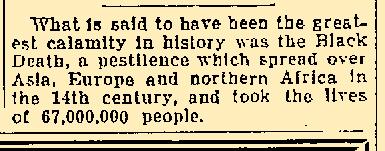Poverty
Scarcity and poverty are humanity’s constant reminders of external dangers that threaten our continued, earthly existence. We, fragile human beings, however, have remained surprisingly resilient in facing this threat as the history of our planet for the past 2500 years (some people would put that number at 60,000 years plus), and more, can testify. But, the going has not always been pleasant and easy for some of our distant relatives and, especially, our late Neolithic cousins. These were the early farmers
Historically, harsh living characteristics remained well-known across the planet because of their biting sting of associated personal hopelessness and pangs of hunger. Survival in the raw elements was accompanied by sweating bodies in the summer and shivering arms and legs in the winter months.

Historians will remind us that in the 14th century in Western Europe, the Black Death scored its biggest deadly gains around 1339 and for years later.
So, it ranks in the first place. Edgar Allen Poe had also reminded us of this truly hideous time period of human history in his classic poem called “The Masque of the Red Death”, which we were all expected to read during our high school years.
A similar epidemic had taken place, but on a smaller scale, in Western Europe during the waning days of Marcus Aurelius’s reign, which historians now refer to as the Antonine Plague.
As a passing comment, we might conclude, at this point, that plagues and epidemics are simply part and parcel of the human condition. Perhaps ours is not the most benign of situations. How might we learn to adjust to such periodic tragedies, and lead meaningful lives?
Help wanted – day laborers, unskilled workers – Operatives needed.
In the first half of the 20th century, Lowell had already established itself and even impressed the technological world of its deeply ingrained position as a “blue collar” town that allowed displaced and often indigent immigrants of various ethnic groups the opportunity to eke out a modest (usually, quite modest) existence in the many textile mills and leather factories (shoes, boots, livery supplies, etc.) in and around the city.
The large mass of these willing and frightened workers constituted the bulk of the productive economy of Spindle City, a title given to this industrial center by manufacturing moguls with a poetic bent in their advertising flair.
The human capital that made these technical and economic accomplishments possible was collectively referred to as the “operatives”, low-skilled workers willing to spend 60 to 70 hours per week in a noisy, dangerous work environment where, often, the ideal plant temperature reached 90 degrees Fahrenheit with the humidity index pegged at around 90%. Naturally, all the factory windows needed to be kept closed to reach these perfect conditions for textile manufacturing.
Soon, however, there were whispered murmurs and sarcastic rumblings among the many uneducated operatives that they were nothing but “mill rats” and theirs was the world of Northern “wage slaves”, similar to the slaves found in the South prior to the Civil War.
Unlike the vaunted aspirations of John Winthrop in his famous quote of establishing a bright and shining city on a hill, the working-class folks in Lowell, who could read, often found day-to-day reality a bit more dour and challenging, to say the least.
An overview of the many employment opportunities that were open to all individuals in the city from 1920 to 1960 (and beyond) is presented in the following two articles. These data were culled from “help wanted” advertisements and other announcements that appeared in the Lowell Sun newspaper over that specific time period. The reader is invited to notice periodic trends in these statistics.
Working Class Employment Opportunities – 20th Century
a term that
